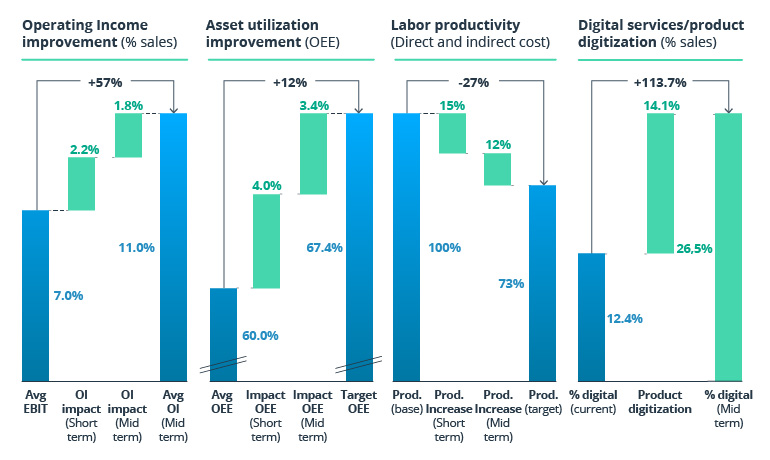The call for supply chain digitization is not new. According to a PwC survey conducted in 2017, 73% of business leaders had already started digitizing their supply chains and planned to complete the process by 2021.
Fast-forward to 2021, and where are we at?
MHI and Deloitte run an ongoing Supply Chain Digital Consciousness Index (DCI) which helps businesses determine their levels of digital supply chain maturity.

Source: MHI — Digital Consciousness Index
The 2020 end-of-year survey revealed that participating organizations scored an average of 2.1 out of 5.0. This means most companies are still in the “Developing” category, with low levels of connectivity and automation. Most are midway through their supply chain digital transformation journey.
Accenture insights also confirm a big gap between aspirations and actual results.
The average digital maturity across our panel of participants in the manufacturing industry is 39% (with 100 percent indicating full deployment), which means companies have completed pilots for some digital capabilities and have begun to scale up.
Indeed, last year was operationally challenging for manufacturers, logistics companies, and suppliers alike. The pandemic accelerated supply chain digitization but also heightened operational constraints.
In 2021, many supply chain managers are revisiting postponed pilots and non-priority projects.
For those of you who would like to make steady progress this year, we have drafted a digital supply chain framework you can use to shape up your business case.
How to accelerate the transition to digital supply chain management
2020 was an unplanned stress test for supply chains. Not everyone passed.
Over 85% of companies struggled with inefficient digital technologies in their supply chains.
Yet over 50% of executives managed to get a stronger grip on supply chain management after the hastened transition to remote work.
So what is a digital supply chain in the current context?
A digital supply chain is a technology-augmented approach to managing all aspects of supply chain networks, aimed at enabling better connectivity among participants, optimizing and automating processes, providing supply chain visibility, and offering forecasting capabilities.
Supply chains have multiple dimensions — processes, ecosystem partners, data flows, physical flows, etc. The goal of digitization in supply chain management is to consolidate them into a homogenous, well-run ecosystem where every participant has top-down and bottom-up visibility and new participants can join at any time.
Given that modern chains span geographies, technical architectures, and business roles, this means a lot of room for optimization across different directions.
The Digital Supply Chain compass maps Supply Chin 4.0 improvements caused by 6 main value drivers

Source: McKinsey — Supply Chain 4.0 – the next-generation digital supply chain.
So far, we have touched on some crucial aspects of supply chain digitization such as supply chain visibility and transparency — the end goal for many leaders.
But there are more underlying jobs to be done if you are early in the supply chain digitization process.
How can you prioritize your targets for digitization to justify your budget? Here’s our approach.
Focus on good governance and a digital mindset
Digital transformation must be driven at the highest level of governance possible and strongly aligned with IT. Otherwise, the project will easily get derailed, postponed, or abandoned.
However, only 25% of supply chain practitioners agree that their digital projects are unified by a single governance process.
Companies that have established governing teams to manage investments, curate lessons learned, and ensure alignment are the ones that have made the most progress on their supply chain digital transformation journeys.
A strong vision and streamlined governance is the first step. A digital mindset that encourages leaders to treat technology as an opportunity, not a foe, is the second step to success.
Sure, you have IT as a delivery and consulting function. But to determine the optimal approach for execution, your teams need your vision and support.
The MHI/Deloitte 2020 survey notes that the three most critical skillsets for supply chain management companies over the next five years will be:
- Project management, leadership, and strategic planning
- Problem-solving and critical thinking
- Supply chain management
Let’s put it out there: Every business is morphing into a technology company.
If your executives are not keen or excited about the growing role of technology in supply chain management, you’ll struggle to remain competitive.
Oftentimes, such resistance comes from a lack of knowledge. That is why many companies are heavily investing in upskilling and reskilling of non-technical roles. Walmart, for instance, has an employee upskilling program aimed at helping employees develop technical, leadership, and role-specific skillsets for emerging roles in IT, software engineering, and digital supply chain management.
Read also: Media Supply Chain
Assess target areas for upgrades
Ultimately, supply chain digitization can drive up operational costs.
According to a Digital Supply Chain initiative (DSCi) assessment, among 24 companies assessed, digitization led to a:
- 20% decrease in procurement costs
- 50% reduction in supply chain costs
- 10% growth in revenue
However, to gain these results, significant investments are required. Supply chains are complex, with many components due for digitization:
- Logistics
- Procurement
- Asset analytics
- Operations analytics
- Supplier management
- Warehousing and fulfillment
- Supply chain demand forecasting
- Efficient spare parts management
- Customer relationship management
- Supply chain visibility and traceability
Your industry, current level of technical maturity, and business goals will dictate which area is due for an immediate upgrade.
Most US-based manufacturing leaders, for example, prioritize the following areas for supply chain digitization:
- 35% — Planning and scheduling
- 26% — Manufacturing and distribution
- 22% — Analytics and visibility
Have a sit down with your business leaders. Get their scoop on what’s working and what’s not. Seek out upgrade opportunities that can help contain costs and drive short-term measurable return on investment (direct and indirect). If you tackle the low-hanging fruit and succeed with execution, you will be better able to justify the need for more complex digitization projects.
Determine your approach to supply chain integration
Supply chains contain multiple participants, from raw material suppliers to last-mile logistics companies. Supply chain digitization assumes establishing common ground among them for interactions and data exchanges.
Understandably, there’s a lot of moving parts and siloed systems standing in the way of supply chain integration.
The solution? Unifying communication with an EDI and API layer.
- Electronic data interchange, or EDI, isn’t a new technology, and it’s compatible even with legacy on-premises systems. A protocol for standardizing data exchanges between different systems, EDI uses the AS2, FTP, and SFTP connectivity standards, which most older systems support. By automating processes, EDI speeds up business cycles by 61%, as it reduces time delays associated with manual data processing.
- APIs (application programming interfaces) are a newer connectivity standard, primarily employed for cloud-based applications. APIs enable real-time connectivity via more flexible REST and HTTP/S protocols. The speed, throughput, and versatility of APIs trumps EDI in supply chain management. Yet using an API often requires deeper transformations of legacy systems and migration to a microservices architecture.
Many digital supply chain solutions leverage both EDI and APIs to ensure tight integration between on-premises and cloud-based systems. Though such dual use comes with certain complexities in terms of interoperability, since EDI only works with EDIFACT, X12, RosettaNet, or proprietary data formats, whereas APIs consume data in JSON or XML formats.
Address legacy infrastructure
Integration is one issue plaguing legacy systems. Others include slow performance, low interoperability, high maintenance costs, and nearing EOS dates.
Given that most supply chain environments are now hybrid, legacy systems pose a challenge to ongoing digitization. Among supply chain management companies attempting digitization, 23.5% admit that legacy technology or infrastructure is a barrier to implementing new technologies.
So what can you do with legacy supply chain management products?
Let’s take a look at some options and digital supply chain examples from leaders who have powered through.
Standardization and consolidation. As per a Boomi survey, 76% of EMEA business leaders pursue the standardization and consolidation route for legacy enterprise resource planning (ERP) apps. That makes sense, given that a lot of earlier supply chain digitization attempts often ended with a proliferation of inquiry-only applications rather than a proper update.
Subsequently, many companies now spend IT budgets on supporting a bloated product portfolio across operating sites and subsidiaries. Running a comprehensive inventory and identifying candidates for consolidation isn’t the most exciting task, but it’s an important one.
Application migration and modernization. Does every legacy supply chain management app need to get to the cloud? No. Many data warehouses are more cost-effective to host locally. Yet systems crucial for improving connectivity such as CRMs, ERPs, fleet management software, and procurement portals can benefit a lot from the elasticity, real-time connectivity, and universal accessibility cloud computing provides.
Again, you’ve got options here. You can migrate to a service-oriented architecture (SOA) first instead of going all granular with microservices. Also, you can treat migration as an opportunity to implement new solutions for on-the-ground teams and ecosystem partners.
For example, we recently worked with a US rubber goods manufacturer. During a fleet software development project, the company noticed that their core platform was challenging to extend and had a high cost for implementing new features. So instead of meddling with extending it and implementing new features, we advised building a separate mobile application for the on-the-ground maintenance team that would effectively connect with the client’s ERP system via a cloud-based middleware platform. Doing so significantly reduced time to market and resulted in higher end-user satisfaction.
However, if you’re in for end-to-end supply chain transformations, we’re here for you too.
IT infrastructure migration and optimization. Another option is to leave core apps in place (for now) and instead optimize the supporting infrastructure — data centers, network performance, cybersecurity protection, data management, and data governance, among other things. Subpar infrastructure also adds to the costs of keeping the lights on, not to mention its impact on application performance.
Even if you’ve already migrated some supply chain processes to the cloud, your job is far from done. Cloud computing costs can add up fast unless contained, especially in a data-heavy function such as supply chain management. Cloud security, data privacy, and secure identity management for all ecosystem participants are other chores to handle. What’s more, you’ll likely need to connect disparate cloud-based and on-premises systems to enable better end-to-end visibility and analytics.
Case in point: The Nuance Group, the biggest operator of airport retailers, was struggling to maintain optimal stock levels in their Australian duty-free stores. The remote location was prone to stock outages as well as excess inventory due to subpar visibility. Nuance Group decided to replace its manual inventory tracking and ordering app with a forecasting and inventory optimization system. The system collects sales data along with other insights on customer behavior, then churns out suggestions for optimal replenishment orders that are automatically dispatched to suppliers. Post-implementation, Nuance gained more accurate demand forecasts and reduced inventory by 10% to 15% while increasing sales volumes.
The benefits of pushing through with supply chain digitization
You now have an action plan for digital supply chain transformation. Time to put it into action if you want these great things to happen.
Value creation from an end-to-end digital transformation

Source: Accenture — The Race for Digital Operations Transformation
- Reduction in operating costs. Over 80% of supply chain managers name “cost reduction” as their prime driver for analytics-related projects. BCG reports that some of their clients reduced costs by 10% to 20% after going through with digitization.
- Lift in income. Businesses recorded a three to six percentage point improvement in EBT, equivalent to $70 million on average, after completing supply chain digitization projects.
To conclude
Digital supply chains are the present for most industries, as everyone has already made certain progress towards digitizing at least some functions. But we are only approaching the cusp of something even bigger — cross-industry ecosystems and seamless interoperability between partnering organizations working jointly on delivering a stellar experience for consumers.
Time to work on your digital supply chain management strategy! Contact Intellias to learn how we can help you connect disparate systems and upgrade your architecture.



